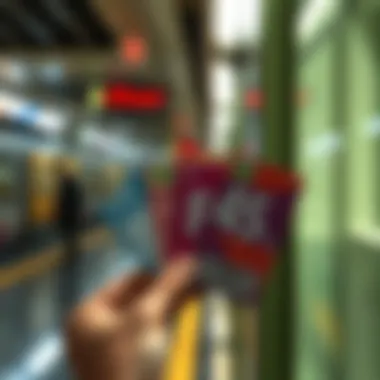Exploring the Pricing Structure of Metro Dubai


Intro
Dubai's rapid development has not only reshaped its skyline but also transformed its commuting landscape. The metro system stands at the heart of this metamorphosis, attracting residents and investors alike. As the city continues to grow, the influence of metro pricing on commuting habits and real estate dynamics becomes increasingly significant.
This examination explores the intricate pricing structures of Dubai's metro system. We'll delve into the fare options available, the nuances of ticket purchasing methods, and the implications of these costs on the daily lives of commuters. In addition, we'll uncover the economic impact of metro pricing on the real estate market, offering insights for potential investors and residents looking to navigate this complex terrain.
Understanding the relationship between metro prices and urban living is crucial—whether you're a local resident trying to gauge commuting costs or an investor looking to capitalize on burgeoning growth in the area. Let’s embark on a thorough analysis of this vital aspect of Dubai’s infrastructure and its ripple effects throughout the city.
Market Trends
Current Real Estate Market Conditions
Over the past few years, Dubai has seen a dynamic shift in its real estate market, largely influenced by affordable metro travel options. The price of commuting can significantly determine the desirability of residential areas. Areas with direct access to the metro system are generally witnessing increased property values, making them appealing to both investors and homebuyers.
For example, neighborhoods such as Business Bay and Downtown Dubai have seen substantial increases in rental rates, driven partly by their proximity to metro stations. Notably, recent data shows that properties near metro lines are commanding premiums, indicating a direct correlation between transport accessibility and real estate prices. Investors are wise to consider these factors when scouting for viable properties.
Future Projections and Growth Areas
Looking ahead, the metro system is poised for further expansion, with new lines and stations being planned. This development will likely open up additional areas that may currently be considered less desirable, yet hold potential for future growth.
Overview of Metro Dubai
Understanding the metro system in Dubai is not just about commuting; it’s a reflection of the city's rapid urbanization. With a remarkable network that connects various parts of the city, the Dubai Metro serves as a lifeline for both residents and visitors. This section will delve into the significance of the metro system in Dubai, emphasizing how its development aligns with the city’s broader goals of sustainability and modern infrastructure.
A well-planned metro system not only eases traffic congestion but also plays a critical role in enhancing the quality of life for its users. The introduction of efficient public transport options encourages people to opt for mass transit over personal vehicles, which in turn reduces carbon emissions. Moreover, the metro’s accessibility positions it as a vital aspect of urban planning, influencing economic activities nearby.
Key Benefits of Dubai's Metro System
- Economic Growth: Each metro station can lead to increased business for local shops and services, improving the overall economic landscape.
- Sustainable Transport: A shift towards using the metro can contribute significantly to reducing the city’s carbon footprint, promoting Dubai as an eco-friendly destination.
- Urban Connectivity: Connecting diverse neighborhoods and attractions fosters a sense of community and encourages cultural exchange.
"A robust metro system acts as the backbone of a thriving metropolis, linking people with opportunities while paving the way for future expansion."
In essence, the overview of Metro Dubai sets the stage for understanding its impact on various facets of life in the city. It is essential to appreciate the intricate balance between convenience, economic viability, and environmental stewardship within this urban framework.
Pricing Structure of Metro Dubai
Understanding the pricing structure of Metro Dubai is crucial for both daily commuters and potential investors in the local real estate market. The cost associated with using the metro system directly influences commuter choices, shaping their travel habits and preferences. Additionally, the pricing model impacts urban mobility, sustainability, and accessibility—therefore, it plays a significant role in Dubai's broader economic landscape. As we dissect the components of metro pricing, we will explore ticket types, single journey fares, and the intricacies of the Nol Card pricing, ensuring that both locals and expatriates can navigate the system effectively.
Ticket Types Available
The Dubai Metro offers a range of ticket types designed to cater to diverse commuting needs. Each ticket type serves a particular purpose, from occasional travelers to daily commuters. Here’s a closer look:
- Standard Tickets: Ideal for infrequent users, these tickets allow one-time travel between stations. They are straightforward in terms of pricing but may not be the most economical choice for regular riders.
- Silver Nol Card: A prepaid smart card, the Silver Nol card is handy for regular users. It can be loaded with funds and used for multiple journeys, allowing for quick and easy access to the metro.
- Gold Nol Card: Designed for those desiring a touch of luxury, the Gold Nol card offers access to the gold class cabins, providing a more comfortable travel experience.
Each ticket type presents unique benefits and considerations, making it essential for users to evaluate which option best suits their commuting habits and lifestyle needs.
Single Journey Fares
The single journey fares on the Dubai Metro are calculated based on the distance traveled, a model designed to promote fair pricing while encouraging more extensive use. The fare structure is tiered, meaning:
- Short trips (from 1 to 3 zones): These typically cost around 3 AED, making them affordable for those who may only need to make quick commutes across the city.
- Medium distance (3 to 6 zones): The price escalates, ranging from 5 to 7.5 AED, reflecting increased travel distance and the associated costs.
- Long trips (more than 6 zones): For those who need to traverse a significant portion of the metro network, fares can reach up to 10 AED.
This system incentivizes passengers to consider their travel needs carefully, determining whether a single journey fare is worth it or if a Nol Card might be the more economical option in the long run.
Nol Card Pricing
The Nol Card pricing effectively caters to a range of user preferences, with several options suiting different travel styles. Cards can be acquired in various forms, each with its own cost:
- Silver Nol Card: Costs 25 AED, of which 19 AED is usable for travel, allowing riders to start using the metro immediately after purchase.
- Gold Nol Card: Priced at 30 AED, this card is aimed at those who wish to travel in premium coach comfort. It's particularly sought after by those who value a more luxurious metro experience.
- Personal Nol Card: This card is slightly more expensive but offers the benefit of customizable features, such as personalized designs and added benefits.
"The Nol Card system is designed not only for convenience but also to reward regular use, providing users with added flexibility along with significant cost savings over time."


Choosing the right type of Nol Card can lead to substantial savings, especially for those who rely on the metro as their primary mode of transport.
In summary, the pricing structure of Metro Dubai encapsulates various ticket types, single journey fares, and Nol Card pricing options. Each component is crafted to meet the needs of different sectors of the population—from daily commuters to occasional users—creating a system that promotes mobility while accommodating financial considerations.
Factors Influencing Price Variation
Understanding the dynamics behind the pricing variations in the Dubai Metro system is crucial for a thorough grasp of how metropolitan transport affects commuter choices and urban development. Several particular elements play a significant role in determining how much a ride will cost. By delving into economic factors, time-based pricing, and geographical zones, we can uncover the subtleties that influence fare structures.
Peak Vs Off-Peak Pricing
Pricing during peak times tends to be notably higher than during off-peak hours. It’s a common practice in urban transit systems worldwide, designed to manage demand and ensure smooth operations. In Dubai’s metro system, peak hours are typically weekdays from early morning until mid-morning and then again during the evening rush. During these times, most commuters are going to or coming home from work, creating a surge in metro usage.
Conversely, the off-peak hours—late mornings through afternoons—show a considerable drop in the number of passengers. The price difference aims to incentivize users to travel during less busy times, helping to flatten the load on the train system. This can lead to a more comfortable and efficient travel experience, as well as potentially lower costs for those more flexible in their schedules.
"Peak pricing is not just a matter of revenue; it’s about balancing the flow of commuters to maintain service quality."
So for those strategically managing their travel times, there's a chance to save a bit of cash while simultaneously aiding in easing the congestion along the metro lines.
Zone-Based Fare System
The zonal fare pricing structure uniquely positions itself within Dubai's multi-dimensional urban landscape. The metro network is divided into specific zones, and fares are determined by the number of zones you travel through. This variable fare system provides a structured way of charging passengers based on their travel distance, which can prove beneficial for long-distance commuters who frequently traverse multiple zones.
Typically, the specifics of fare determination follow a straightforward principle: the more zones crossed, the higher the fare. However, investing in a Nol Card can offer several advantages such as discounts on standard fares, promoting its use among regular travelers. This encourages higher use of public transport while providing flexibility and clarity regarding costs:
- Zone 1 to Zone 2: AED X
- Zone 1 to Zone 3: AED Y
- Zone 2 to Zone 3: AED Z
Understanding this structure helps commuters plan their trips not only in terms of expenses but also in terms of time management. It is crucial for investors and property managers to consider these dynamics as they impact the desirability of locales near metro stations, where accessibility might influence rental prices and demand.
In summary, factors such as peak pricing and the zone-based fare system play key roles in shaping the fare landscape of Dubai’s metro. They're essential for providing effective public transport that balances operational efficiency with rider needs.
Purchasing Tickets and Fare Systems
The framework for purchasing tickets and fare systems is pivotal for any metro system, with Dubai's Metro being no exception. This aspect not only defines how commuters interact with the metro but also shapes the overall experience and accessibility of the transportation network. Understanding the various methods of buying tickets, along with their respective benefits and disadvantages, is crucial for residents, expats, and investors alike.
Methods for Buying Tickets
Buying tickets for the Dubai Metro can seem complicated at first glance, especially for newcomers. However, once familiar, it's a straightforward process. Broadly, there are several methods available to purchase tickets.
- Automated Ticket Machines: These machines are present at every metro station. They accept cash and Nol cards, allowing passengers to purchase single tickets or top up their Nol card balances quickly.
- Customer Service Counters: Located in most stations, these counters are helpful for travelers. They provide assistance in ticket purchasing and can also offer insights into the best travel options based on your route.
- Mobile Apps: The Dubai Roads and Transport Authority (RTA) offers a user-friendly app. This platform allows users to purchase tickets, check schedules, and even plan journeys in an efficient manner without fuss.
- Online Purchases: Through the RTA's website, commuters can also manage their ticket purchases, thus avoiding any potential queues at stations.
Having various methods provides convenience and flexibility tailored to commuter needs. It means that whether you are tech-savvy or prefer face-to-face interaction, there is a way to suit your style.
Online vs Physical Purchase
When discussing ticket purchasing, it's essential to consider the pros and cons of online versus physical methods.
- Online Purchases: This method simplifies the buying process. Customers can avoid long lines and make purchases at their leisure. The RTA website and mobile app can be accessed anytime, making it especially useful during peak commuting hours when kiosks become crowded. Additionally, online methods often allow for a more comprehensive look at available fare options and promotions.
- Physical Purchases: Though not as convenient, visiting a metro station offers a personal touch. Commuters can interact with staff, which can be particularly valuable for those who are unfamiliar with the ticketing system. Furthermore, purchasing tickets on-site can be an opportunity to gather more information about the metro routes and services.
"Navigating the ticket purchasing landscape of Dubai Metro can significantly enhance your commuting experience, leading to informed decisions and smoother travel."
For further information on Dubai's metro ticket systems, visit the official RTA website or check out Wikipedia for more details.
Impact of Metro Pricing on Commuter Behavior
The pricing of the metro system in Dubai plays a crucial role in shaping the behavior of commuters, making it a focal point for analysis within this article. Understanding how these prices affect choices can shed light on broader economic implications and commuting patterns. Factors such as affordability, convenience, and accessibility all contribute to the way individuals prefer to travel, especially in a city as bustling as Dubai.
One essential element to consider is that metro pricing can influence modes of transportation. As fares fluctuate, it becomes necessary to evaluate how these changes may lead commuters to choose the metro over private vehicles or taxis. Offers such as discounts during off-peak hours can further entice different demographics to ride the metro more frequently. It’s not just about the price; it’s about whether commuters see value in their transport choices.
Think about the implications for affordability. For residents who commute daily, the cost of metro tickets can add up over time. Thus, a pricing structure that allows commuters to save, especially for regular users who buy Nol Cards, hugely impacts their decision to use public transport. Lower fares stimulate usage, while rising costs could push people back to their cars, causing traffic congestion and straining road infrastructure.
"The more a city invests in improving its public transport, the more likely its residents are to utilize it, especially when costs are kept reasonable."


Commuter Preferences
Commuter preferences significantly impact how the metro operates within Dubai’s transportation ecosystem. Familiarity with ticket types and various fare options available influences these choices. For instance, regular riders often lean towards using Nol Cards that provide discounts and easier access. In contrast, tourists or occasional users might favor single-journey tickets due to their simplicity.
Factors like convenience also come to play. If the metro pricing is high compared to other options, many might opt for alternatives such as carpooling or ride-hailing services instead. This leads to a tipping point: the more usability is integrated with price points, the greater the likelihood of an efficient transit system. Commuters are inclined to balance their budgets with travel time, so clear communication about pricing structures and benefits remains vital.
- Factors influencing preferences include:
- Affordability
- Convenience
- Knowledge of ticketing options
- Value-added features, like free Wi-Fi or cleanliness
Effects on Public Transport Usage
The pricing of Dubai's metro system doesn’t just affect individual commuting choices; it shapes the overall frequency of public transport usage. When fares are set intelligently, we witness a significant uptick in ridership. Conversely, sharp increases in fares lead to declines, as shown in numerous transport studies across global cities.
In essence, the financial aspect of metro pricing directly correlates with commuter turnout. In peak hours, when tickets tend to be busier, the benefits of using the metro can outweigh cost concerns, prompting commuters to utilize this mode rather than face the frustrations of road traffic. On the other hand, during off-peak hours, dare I say there can be a perception that prices could be cut to attract more riders.
It's also crucial to look at public policy strategies, as subsidizing public transport fares can ensure a stable and increasing user base. With effective pricing strategies
- Cities can manage congestion,
- Enhance the appeal of metro transport, and
- Promote sustainability by reducing carbon footprints through decreased car usage.
As we analyze these dynamics, it becomes evident that balancing price points effectively impacts commuter behavior, ultimately determining the future viability of public transport in Dubai. Through continued adjustments and considerations, it can achieve not only satisfaction among riders but also a robust commuting culture that complements the urban landscape.
Regional Comparisons
When discussing Metro Dubai Prices, it’s essential to place this subject in a broader context of public transportation systems around the globe. Regional comparisons serve as a mirror reflecting the effectiveness, efficiency, and overall value of Dubai’s metro system. Understanding how Dubai's metro fares stack up against other renowned transit systems sheds light on not only economic aspects but also social implications of urban mobility.
Dubai Metro Vs Other Global Systems
Dubai’s metro system holds its own on the world stage, but how does it fare compared to other cities? Consider cities like London, New York, and Tokyo, which have been pioneers in metro transit.
- London Underground: The Tube is famed for its vast network, serving as an indispensable lifeline for Londoners. Its pricing can be steep, especially for tourists unfamiliar with its zone system.
- New York City Subway: NYC offers an extensive service, crammed with cultural connotations and a robust fare system. Unlike Dubai, the subway operates a flat fee despite varied distances, which makes comparisons between base fares tricky.
- Tokyo Metro: Known for punctuality and efficiency, the Tokyo system has a unique fare calculation based on distance traveled, often perceived as complex but effective for local commuters.
Here are some key considerations when comparing:
- Fare Structure: Dubai's metro pricing adopts a zone-based system, which means costs might differ depending on how far you’re traveling. This structure can be advantageous for short trips while making longer journeys slightly pricier.
- Accessibility and User-Friendliness: The ease of use is a significant consideration in any urban transport system. Dubai's metro, with its user-friendly maps and multilingual support, contrasts with systems like Paris, where navigating can be daunting for newcomers.
- Investment in Infrastructure: Unlike many older systems, Dubai has invested heavily in state-of-the-art technology, from ticketing to maintenance. The relatively young age of Dubai metro as a system allows it to leverage modern systems that older metro systems are struggling to upgrade.
"Understanding regional transport pricing not only aids commuters but also helps investors gauge market trends and real estate values."
Exploring these differences provides crucial insights for housing developers, property managers, and potential investors looking at the impact of metro services on property values. A well-structured metro can elevate an entire neighborhood's standing, making accessibility a vital consideration in property investment decisions.
Furthermore, future trends may reshape the fare structures globally, including Dubai’s approach. Awareness of these factors equips stakeholders to make informed decisions while navigating the interconnected worlds of transit and real estate.
Future Trends in Metro Pricing
Exploring future trends in metro pricing is crucial for both residents and investors in Dubai, as it reflects the evolving dynamics of urban mobility and economic factors at play. Being aware of potential fare innovations and adjustments can provide significant insights into how the metro system will cater to its user base in the coming years. Understanding these trends not only informs commuters about their upcoming expenses but also influences the broader economic landscape, including real estate investments and neighborhood vitality.
Innovations in Fare Structures
The introduction of innovative fare structures is poised to reshape the way commuters interact with the metro system. One significant trend is the potential for dynamic pricing models, which adjust fares based on demand. This approach can help balance ridership during peak hours, ensuring a smoother flow of passengers. For instance, during rush hour when trains are crowded, fares might slightly increase, encouraging some travelers to take the metro at less busy times.
Additionally, the implementation of technology to streamline fare payment could enhance user experience. Concepts like contactless payment methods and mobile applications for ticket purchasing are gaining traction. Such advancements not only make the payment process more convenient but also promote increased usage of the metro system. An intelligent fare management system could reward frequent users with discounts, making public transport even more attractive.
Furthermore, the growing emphasis on sustainability could influence fare innovations as well. If the metro can position itself as a greener option compared to other forms of transportation, we might see subsidies or reduced fares aimed at promoting eco-friendly travel.
“Innovations in fare structures will likely play a pivotal role in how the Dubai metro system adapts to future commuting patterns.”
Potential Price Adjustments
Price adjustments in Metro Dubai not only depend on operational costs but also reflect economic conditions and user behavior. While price hikes are sometimes necessary to manage maintenance and service improvements, they must be approached with care. Too steep an increase could deter users, negatively impacting public transport adoption.
Government policies will likely play a key role in shaping these adjustments. Any changes in gas prices or shifts in public transport funding could trigger reevaluation of metro fares. Similarly, global economic factors—like inflation rates—will lead to discussions around fare modifications.


Some potential strategies could include gradually introducing incremental increases rather than sudden jumps in pricing. This could ease commuters into necessary changes without creating noticeable dissatisfaction. It’s essential that any fare changes are communicated transparently, allowing users enough time to adapt to their new commuting budgets.
In sum, staying informed about future pricing trends and adjustments is vital for residents and investors alike. As Dubai continues to evolve, understanding these dynamics not only helps in budgeting daily commutes but also in making strategic real estate investments.
The Connection Between Metro Prices and Real Estate
Dubai's metro system is more than just a means of transportation; it serves as a structural backbone for urban development and plays a pivotal role in the real estate landscape of the city. Understanding the connection between metro prices and real estate is essential for potential buyers, investors, and property managers looking to navigate the complexities of Dubai’s housing market. The nuances of this relationship can greatly influence property value, accessibility, and neighborhood dynamics, making it a topic worthy of in-depth exploration.
Impact on Property Values
The price of metro fares directly correlates with property values in the surrounding areas. When the metro system expands or when fare prices are adjusted, real estate professionals monitor this closely. For instance, neighborhoods with metro stations often see a surge in property values due to increased demand. Buyers generally favor locations with good public transport options, taking into account that a reliable metro can dramatically reduce commuting times.
A study conducted by the Dubai Statistics Center found that properties located within a 500-meter radius of metro stations typically command a higher price per square foot compared to those farther away. As demand rises for these well-located properties, developers are encouraged to invest in these regions, creating new housing options and potentially integrating more mixed-use developments. This trend can perpetuate a cycle where elevated property values can be attributed partly to metro prices and the convenience they offer to urban dwellers.
Furthermore, fluctuations in fare pricing can act as an economic indicator. When prices increase, it may signal to developers and investors to reassess the viability of projects in certain neighborhoods. Lower fares, conversely, could hint at continued investment in public transport, which might make a particular locale more attractive for future growth.
"The metro acts as a game changer; its price structure can determine the trajectory of entire neighborhoods, altogether altering the real estate map of Dubai."
Metro Accessibility and Neighborhood Development
Metro accessibility is often the linchpin for neighborhood development. As Dubai's metro prices remain relatively affordable compared to other global cities, it encourages more people to utilize the system. This rise in commuter traffic can stimulate local economies and pave the way for better amenities and infrastructure development within neighborhoods. Property developers are increasingly designing residential and commercial projects with direct access to metro stations to meet this growing demand.
Real estate projects like Dubai Marina and Business Bay have seen transformative growth linked closely to metro accessibility. These areas thrive on the influx of residents and businesses seeking the benefits of quick, efficient metro transport, which in turn enhances the overall appeal of the neighborhood. Local markets, shops, and restaurants often spring up near metro stations, fostering community engagement and urban vibrancy.
Moreover, the influence of the metro extends to zoning laws and urban planning practices. Local governments can prioritize the allocation of resources to neighborhoods with metro accessibility, enhancing landscaping, parks, and public facilities, impacting property values and desirability. Investors are likely to pay close attention to these trends, knowing that a property within walking distance of a station is not just a good buy for the present but also a smart long-term investment.
In summary, the interplay between metro prices and real estate in Dubai goes beyond simple fare structures. It encapsulates the very essence of urban development, as property values and neighborhood dynamics often hinge on the accessibility and economic implications linked to the metro system. Understanding these connections can aid stakeholders in making informed choices—whether they are homebuyers looking for a place to live, investors probing for profitable ventures, or property managers striving to enhance the value of their assets.
Considerations for Expats and Locals
Understanding the pricing structure of Dubai's metro system is crucial for both expats and locals navigating life in this bustling city. The metro serves as more than just a mode of transport; it’s a lifeline connecting individuals to opportunities, residences, and leisure activities. It’s particularly important for newcomers to grasp the fare options available, as this not only affects daily commuting costs but also overall budgeting for living expenses in a city known for its rapid development and varied lifestyle costs.
Understanding Fare Options
When it comes to fare options within the Dubai metro system, the diversity is quite significant and merits careful consideration. Here are the primary options:
- Single Journey Tickets: Ideal for those who prefer a straightforward approach. This option allows individuals to purchase a ticket for one trip only. However, it’s worth noting that this might not always be the most economical choice for regular commuters.
- Nol Cards: Offering flexibility and savings, Nol cards come in different types—Red, Blue, Green, and Silver—each tailored to various user preferences. For expats, having a Nol card is essential; it allows for easy tap-in and tap-out access across the metro lines and even on public buses. Not to mention, it often provides discounted fares compared to single journey tickets.
- Monthly Passes: Frequent users of the metro might find monthly passes beneficial. These passes allow for unlimited travel across specified zones for a fixed rate, making them a smart choice for those commuting to work daily or attending regular events. It’s a sensible investment for expats settling down in Dubai, as it simplifies budgeting.
- Special Offers and Promotions: Occasionally, RTA (Roads and Transport Authority) rolls out special offers that could significantly benefit both locals and expats. Staying updated with these can lead to considerable savings, especially during peak travel seasons or local events.
In addition to these options, being aware of the pricing differences between peak and off-peak hours can optimize commuting costs. To navigate this effectively, expats should also consider the zone-based fare system, as traveling longer distances impacts overall expenses.
"The right fare choice can make a tangible difference in a commuter's daily routine and budget."
In summary, awareness of the fare options available is vital for expats and locals alike. They should take the time to evaluate their commuting needs and choose the fare system that best aligns with their lifestyles. This not only enhances the commuting experience but also ensures that financial resources are allocated efficiently in the vibrant yet sometimes costly environment of Dubai.
Culmination
In wrapping up our exploration of Metro Dubai pricing, it becomes clear just how pivotal this system is for the city’s movement and economic flow. The metro isn’t just a shiny transit solution; it’s a vital component that shapes the everyday lives of its users, from expats to tourists, and significantly influences the urban landscape of Dubai.
Recap of Key Insights
The article shines a light on several highpoints:
- Pricing Structure: We dissected the various ticket types and fares, highlighting how they cater to diverse commuter needs, from single journeys to regular riders.
- Factors Influencing Pricing: Understanding how peak and off-peak times affect fares helps commuters make smarter choices that align with their schedules and budgets.
- Real Estate Impacts: It's clear that proximity to metro stations can elevate property values, making it essential for investors to pay attention to areas around these hubs.
- Future Trends: Innovations in fare structures may lead to more flexible pricing, which can reshape commuting patterns and implications for urban planning.
As we’ve seen, being informed about this pricing landscape not only enhances commuting experiences but also opens up avenues for sound investments in Dubai’s ever-evolving real estate market.
The Importance of Informed Fare Choices
Making educated decisions about fare purchases is central for both daily commuters and potential investors. For locals and expatriates, understanding the nuances of ticket pricing and fare systems can result in substantial savings over time. Relying solely on intuition or basic knowledge might lead to needless expenses. A well-planned approach to fare selection can significantly impact one’s personal budget and lifestyle.
Moreover, recognizing how pricing structures may evolve could guide long-term investment choices in the property market.
In summary, knowing the ins and outs of metro pricing unleashes numerous benefits; it’s not simply about hopping on a train but rather about making informed decisions that can enhance overall quality of life and financial health. Thus, as Dubai continues to develop, these fare choices become increasingly integral to navigating a bustling, dynamic city.
"Knowledge empowers our choices in every aspect of life, especially in an urban setting where every dirham matters."
For a deeper dive into metro systems worldwide and their pricing structures, consider resources from wikipedia.org and britannica.com. Details on current transportation policies can be explored through relevant city government sites like *.gov.















